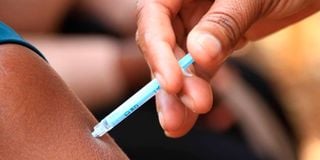What you need to know about thrombosis and Covid-19

A health worker administers Covid-19 vaccine on September 20, 2021.
This year, more than ever, blood clots have created a fuss, as they were said to be a side effect of taking some Covid-19 vaccines.
In what started as grist to the mill for anti-vaxxers, the European Medicines Agency later found a positive correlation between some vaccines (Oxford AstraZeneca and Johnson & Johnson) and blood clots, albeit, rarely.
But how well do people know how and why the clots occur?
To create awareness on blood clots on this World Thrombosis Day, the Nation spoke to Dr Gordon Ogweno, the secretary-general of the Kenya Society on Thrombosis and Haemostasis.
Here is what you need to know:
What is thrombosis?
It is the change of blood from liquid to solid clots inside the blood vessels of a living organism. The consequence is an obstruction to blood flow, especially in vital organs such as the brain, where it can lead to a stroke; the heart, where it can cause a heart attack; and the veins, where it is responsible for deep venous thrombosis (DVT).
Two Covid-19 vaccines have been cited to cause blood clots, which I understand are related to thrombosis, what exactly happens to the body?
The vaccines stimulate the body to release chemicals that destroy the offending germs (pathogens, in this case, Covid-19). The antibodies are directed against some parts of the virus which may share chemical composition to the small blood cells (platelets).
In the course of interacting with platelets, they may be transformed to initiate the blood-clotting process. This process is similar to what the blood-thinning drug does as a side effect (heparin induced thrombocytopenia, HIT). The cases are rare but have been observed in some people. Blood thinners are drugs that prevent blood from forming clots.
One of the symptoms of severe Covid-19 is blood clots, what does the virus do to bring about such symptoms?
The virus enters the body, binds to receptors on the lining of blood vessels. In the course of body reactions, immune chemicals such as antibodies and cytokines (proteins responsible for the growth of immune systems and blood cells) not only destroy the virus but also destroy the adjacent lining of blood cells.
The injury initiates blood clot formation to try to prevent the further spread of the virus. The consequence is blood clot formation at such injury sites. The common sites are the tissues or organs where the coronavirus is highly concentrated such as the lungs (pulmonary thrombus), brain (stroke) skin (gangrene).
What are the most common types of thrombosis and how do they manifest?
The common types of thrombosis are the ones formed in the veins of the legs (deep venous thrombosis) and lungs (pulmonary thrombosis). On some occasions, the clot can break from the site in the veins and be transported to the lungs (pulmonary thromboembolism).
Since the onset is without warning, sometimes the victims just collapse and die. The cause is only known during postmortem. In case of formation in the limbs, the affected leg is bigger than the corresponding side, feels warmer and painful with evidence of reduced or lack of blood flow. Sometimes the diagnosis is by doing imaging studies when suspected such as Doppler ultrasound (a noninvasive test that can be used to gauge the flow of blood through your blood vessels), CT scan or magnetic resonance imaging (MRI).
What treatment options do we have?
The treatment for thrombosis are prevention by being physically active, drugs such as blood thinners (heparin or alternatives), clot busters (fibrinolytic) and drugs that prevent platelets from aggregating together (antiplatelets such as aspirin).
Why does it claim lives when it is a preventable condition?
Thrombosis is a killer because it develops without warning. Death occurs when the blood flow to the lungs is obstructed (cannot pick up oxygen) or the brain circulation is obstructed (stroke), leading to loss of consciousness.
What are the risk factors that predispose one to thrombosis?
There are many conditions that can predispose one to thrombosis, but generally grouped into three. The first are those factors in the blood that accelerate clot formation, such as contraceptive pills (some, not all), inherited, high blood cholesterol.
The second is related to injury of blood vessels such as cancer, infection, trauma, catheters inserted during medical procedures such as for dialysis or immune-related.
The third category is related to sluggishness in blood flow, such as lack of exercise or physical activity and a sedentary lifestyle. Covid-19 has a unique association with thrombosis, since it destroys the blood vessel lining. It provokes an antibody reaction that initiates clot formation. The victims are confined (less active) due to illness or hospital admission.





